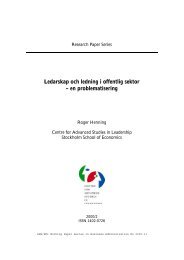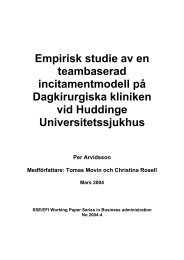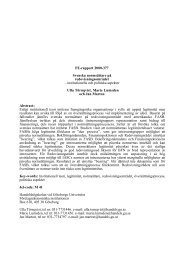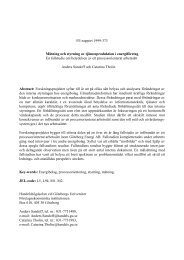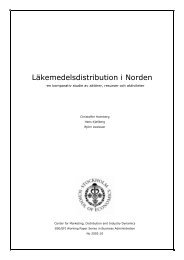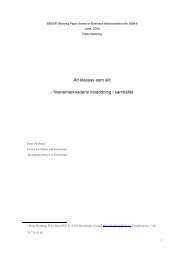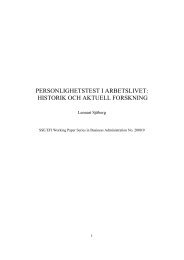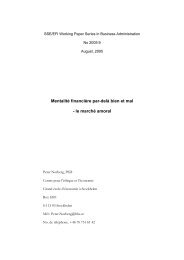Big Five Plus - S-WoBA - Handelshögskolan i Stockholm
Big Five Plus - S-WoBA - Handelshögskolan i Stockholm
Big Five Plus - S-WoBA - Handelshögskolan i Stockholm
You also want an ePaper? Increase the reach of your titles
YUMPU automatically turns print PDFs into web optimized ePapers that Google loves.
143. LoBello, S. G. (1998). Review of the Hogan Personality Inventory (Revised). In J. C.<br />
Impara & B. S. Plake (Eds.), The thirteenth mental measurements yearbook (pp. No<br />
pagination specified). Lincoln, NE: Buros Institute of Mental Measurements.<br />
144. Lord, F. M. (1956). The measurement of growth. Educational and Psychological Measurement,<br />
16, 421-437.<br />
145. Lyness, K. S., & Judiesch, M. K. (2008). Can a manager have a life and a career? International<br />
and multisource perspectives on work-life balance and career advancement<br />
potential. Journal of Applied Psychology, 93, 789-805.<br />
146. Lyubomirsky, S., King, L., & Diener, E. (2005). The Benefits of Frequent Positive Affect:<br />
Does Happiness Lead to Success? Psychological Bulletin, 131(6), 803-855.<br />
147. Lönnqvist, J.-E., Paunonen, S., Tuulio-Henriksson, A., Lönnqvist, J., & Verkasalo, M.<br />
(2007). Substance and style in socially desirable responding. Journal of Personality,<br />
75(2), 291-322.<br />
148. Mabon, H. (2002). Hogans personlighetsinventorium av Robert Hogan och Joyce Hogan.<br />
Svensk version av Hunter Mabon. <strong>Stockholm</strong>: Psykologiförlaget AB.<br />
149. Mabon, H. (2004). Arbetspsykologisk testning. Om urvalsmetoder i arbetslivet. Andra<br />
upplagan. <strong>Stockholm</strong>: Psykologiförlaget.<br />
150. MacCann, C., & Roberts, R. D. (2008). New paradigms for assessing emotional intelligence:<br />
Theory and data. Emotion, 8(4), 540-551.<br />
151. Maddi, S. R. (2006). Hardiness: The courage to grow from stresses. The Journal of Positive<br />
Psychology, 1(3), 160-168.<br />
152. Magnusson, D. (1961). Testteori. <strong>Stockholm</strong>: Almqvist och Wiksell.<br />
153. Magnusson, D. (1967). The generality of behavioral data III. <strong>Stockholm</strong>: Applied Psychology<br />
Unit, Psychological Laboratories, University of <strong>Stockholm</strong>.<br />
154. Magnusson, D. (2003). Testteori. <strong>Stockholm</strong>: Psykologiförlaget.<br />
155. Maitland, S. B., Nyberg, L., Bäckman, L., Nilsson, L.-G., & Adolfsson, R. (2009). On<br />
the structure of personality: Are there separate temperament and character factors?<br />
Personality and Individual Differences, 47(3), 180-184.<br />
156. Markstrom, C. A., Sabino, V. M., Turner, B. J., & Berman, R. C. (1997). The psychosocial<br />
inventory of ego strengths: Development and validation of a new Eriksonian measure.<br />
Journal of Youth & Adolescence, 26(6), 705-732.<br />
157. Marston, W. M. (1989/1928). Emotions of normal people. Ormskirk, Lancs.: Thomas<br />
Lyster.<br />
158. Martin, B. A., Bowen, C. C., & Hunt, S. T. (2002). How effective are people at faking on<br />
personality questionnaires? Personality and Individual Differences, 32, 247-256.<br />
161



